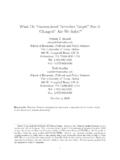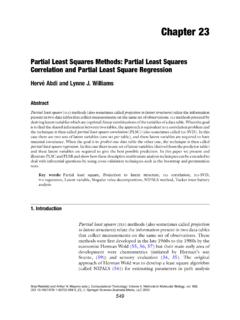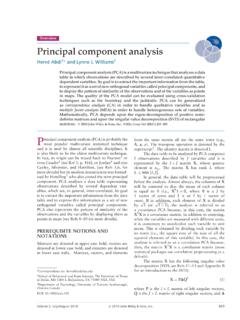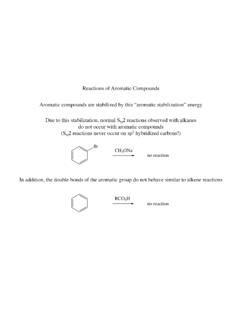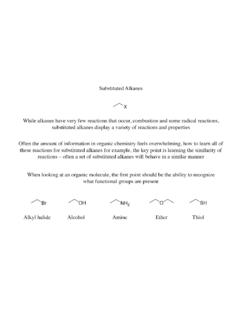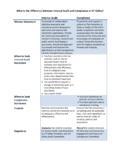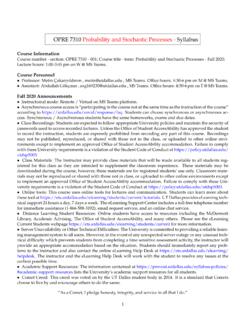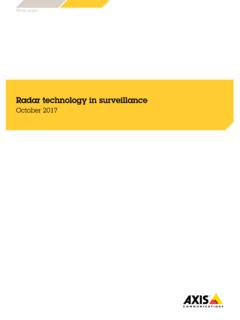Transcription of The Telephone Network - University of Texas at …
1 The Telephone NetworkThe Telephone NetworkAn Engineering Approach Ref: Digital Telephony (John Bellamy) and Fundamentals of Telecommunications (R. L. Freeman)Introduction to Telecommunications Network Engineering (Second Edition), (Anttalainen, Tarmo) EE4367 Telecom. Switching & TransmissionProf. Murat TorlakIntroductory ConceptsIntroductory Concepts Telecommunication means communications at a distance Tele in Greek means at a distance Electrical communications by wire, radio, or light (fiber optics) Traditionally two distinct disciplines: Switching: selects and directs communication signals to a specific user or a group of users Transmission: delivers the signals in some way from source to the far-end user with an acceptable signal quality EE4367 Telecom.
2 Switching & TransmissionProf. Murat TorlakSimple Transmission SystemSimple Transmission System The source may be a simple Telephone microphone, keyboard The destination may be a simple Telephone speaker, monitorSourceDestinationTransmission MediumEE4367 Telecom. Switching & TransmissionProf. Murat TorlakTransmission MediaTransmission Media It can be a seen as a single electrical medium Or, as a cascade of electrical media Networks show a gain or loss. To understand these gains or loss, a good knowledge of the decibel and related measurement units is Telecom. Switching & TransmissionProf. Murat TorlakdB in CommunicationsdB in Communications The db (decibel) is a relative unit of measurement commonly used in communications for providing a reference for input and output levels.
3 Power gain or loss. Decibels are used to specify measured and calculated values in audio systems, microwave system gain calculations, satellite system link-budget analysis, antenna power gain, light-budget calculations and in many other communication system measurements In each case the dB value is calculated with respect to a standard or specified reference. EE4367 Telecom. Switching & TransmissionProf. Murat TorlakCalculation of dBCalculation of dB The dB value is calculated by taking the log of the ratio of the measured or calculated power (P2) with respect to a reference power (P1). The result is multiplied by 10 to obtain the value in dB. It can be modified to provide a dB value based on the ratio of two voltages. By using the power relationship P = V2/R P1P2EE4367 Telecom.
4 Switching & TransmissionProf. Murat TorlakDefinitions of Definitions of dBmdBmand and dBWdBW dBm indicates that the specified dB level is relative to a 1 milliwatt reference. If Power is expressed in watts instead of milliwatts. the dB unit is obtained with respect to 1 watt and the dB values are expressed as dBW. 1mWP2210dBm 10 Telecom. Switching & TransmissionProf. Murat TorlakExamplesExamples Important Note:The decibel (dB) is the logarithm of a power ratio and NOT a unit of power; However, dBW and dBm are units of power in the logarithmic system of numbers Convert the following into dBm or dBW P=1mW, P(dBm)=? P= , P(dBm)=? P=10W, P(dBW)=? P=1W, P(dBm)=?EE4367 Telecom. Switching & TransmissionProf. Murat TorlakdB HintdB Hint dB value=10log104/2=10log102=10 + 3dB Memorize the above relationship The amplifying Network has a 3-dB gain because the output power was the double the input powerNetwork2mW4mWEE4367 Telecom.
5 Switching & TransmissionProf. Murat TorlakTelephonyTelephony The Telephone is connected to Public switched telecommunications Network (PSTN) for local, national , and international voice communications The same connections can carry data and image information (television) The connection to the PSTN may be via local exchange carriers (LEC) End-users, nodes, and connectivitiesEE4367 Telecom. Switching & TransmissionProf. Murat TorlakVoice TelephonyVoice Telephony Transmission of the human voice Voice is a sound signal Analog voice-band channel A channel that is suitable for transmission of speech or analog data and has the maximum usable frequency range of 300 to 3400 Hz. The local serving switch is the point of the connectivity with the PSTN It is the point where the analog signal is Telecom.
6 Switching & TransmissionProf. Murat Torlak20 3003,400 4,00020,000 Hertz (Hz)GuardbandBW available forAnalog voice transmissionBW of Analog CircuitRange of human hearingGuardbandEE4367 Telecom. Switching & TransmissionProf. Murat TorlakTelephone SubsetTelephone Subset It is a device which converts human speech in the form of sound waves produced by the vocal cord to electrical signals. These signals are then transmitted over Telephone wires and then converted back to sound waves for human ears. Microphone Earphone Signaling functionsEE4367 Telecom. Switching & TransmissionProf. Murat TorlakGetting Voice Onto and Off the NetworkElectromagnetSpeaker diaphram (moveable)Permanent magnetVariable magnetic fieldDiaphram (moveable)Granulated carbon4 WiresSound WavesSound WavesHandsetTransmitter (mouthpiece)Receiver (earpiece)Electrical contactsRJ-22 connectorRJ-22 connectorRJ-11 connectors2 wiresEE4367 Telecom.
7 Switching & TransmissionProf. Murat TorlakTelephone Handset Microphone (mouthpiece) consists of a movable speaker diaphragm that is sensitive to both amplitude and frequency The diaphragm contains carbon particles that can conduct electricity. As the human voice spoken into the transmitter varies, the amount of carbon granules that strike the electrical contacts inthe mouthpiece also varies thereby sending varying analog electrical signals out into the voice Telecom. Switching & TransmissionProf. Murat TorlakTelephone HandsetTelephone Handset Earphone (earpiece) Acts in an opposite direction to the mouthpiece. The electrical signal/waves produced by the transmitter are received at an electromagnet in the receiver. Varying levels of electricity produce varying levels of magnetism that, in turn, cause the diaphragm to move in direct proportion to the magnetic variance.
8 The moving diaphragm produces varying sound that corresponds to the sound waves that were input at the transmitter. EE4367 Telecom. Switching & TransmissionProf. Murat TorlakConventional Telephony OperationConventional Telephony OperationEE4367 Telecom. Switching & TransmissionProf. Murat TorlakDialingDialing A combination of 350 Hz and 440 Hz sine waves sent to the Telephone from the central office (CO) indicating that the Network is ready to receive calling instructions Dialing Modes: Pulse and Touch Tone or Dual-Tone-MultiFrequency Each button sends a dual frequency sine wave indicated by the corresponding row and column. Telephone Numbers are decided by ITU internationally and NANP in North America [NP numbering plan]Rotary or pulse dialingEE4367 Telecom.
9 Switching & TransmissionProf. Murat TorlakSubscriber SignalingSubscriber SignalingEE4367 Telecom. Switching & TransmissionProf. Murat TorlakBasic Telecommunications InfrastructurePhoneLocal loopInter-exchange circuitBelongs to IXC (Inter-eXchange Carrier)Belongs to LEC (Local-Exchange Carrier)LATA - ALATA - Btrunk linetrunk lineEE4367 Telecom. Switching & TransmissionProf. Murat TorlakSS7 SignalingSS7 Signaling Common Signaling System 7, also called SS7 or C7, was developed by the in order to increase the efficiency of the public voice system. SS7 is a separate Network whose duties are setting up, tearing down, monitoring, and routing calls on the PSTN. SS7 is akin to TCP/IP in that it operates at several layers of the OSI model. And, like TCP/IP, SS7 is packet-based.
10 It is a software-based system that operates independently of the voice transport itself (the PSTN). SS7 works behind the scenes, so interacting with SS7 is something that the CO switch, not your phone or PBX, must do. SS7 is called an out-of-bandsignaling standard because, unlike DTMF, it doesn't use the same frequency band, or even the same transport, as the voice transmission. Out-of-band signaling is also called CCS, or common channel signaling. It's the technique used by all telecommunication vendors including cellular phone service providers, long-distance companies, and local exchange carriers (LECs). All of these networks share one thing in common: a common bond in SS7. EE4367 Telecom. Switching & TransmissionProf. Murat TorlakSS7 and PSTNSS7 and PSTNEE4367 Telecom.
